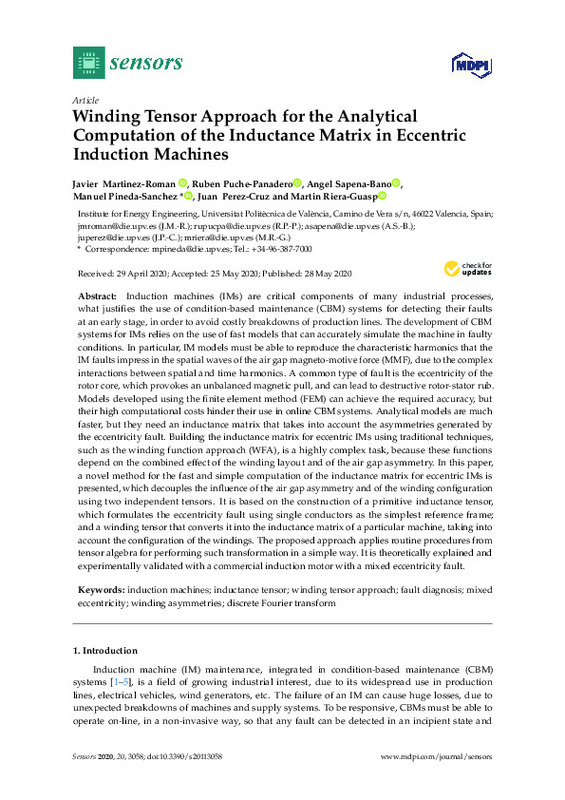JavaScript is disabled for your browser. Some features of this site may not work without it.
Buscar en RiuNet
Listar
Mi cuenta
Estadísticas
Ayuda RiuNet
Admin. UPV
Winding Tensor Approach for the Analytical Computation of the Inductance Matrix in Eccentric Induction Machines
Mostrar el registro sencillo del ítem
Ficheros en el ítem
| dc.contributor.author | Martinez-Roman, Javier
|
es_ES |
| dc.contributor.author | Puche-Panadero, Rubén
|
es_ES |
| dc.contributor.author | Sapena-Bano, Angel
|
es_ES |
| dc.contributor.author | Pineda-Sanchez, Manuel
|
es_ES |
| dc.contributor.author | Pérez-Cruz, Juan
|
es_ES |
| dc.contributor.author | Riera-Guasp, Martín
|
es_ES |
| dc.date.accessioned | 2021-11-05T14:08:01Z | |
| dc.date.available | 2021-11-05T14:08:01Z | |
| dc.date.issued | 2020-06 | es_ES |
| dc.identifier.uri | http://hdl.handle.net/10251/176311 | |
| dc.description.abstract | [EN] Induction machines (IMs) are critical components of many industrial processes, what justifies the use of condition-based maintenance (CBM) systems for detecting their faults at an early stage, in order to avoid costly breakdowns of production lines. The development of CBM systems for IMs relies on the use of fast models that can accurately simulate the machine in faulty conditions. In particular, IM models must be able to reproduce the characteristic harmonics that the IM faults impress in the spatial waves of the air gap magneto-motive force (MMF), due to the complex interactions between spatial and time harmonics. A common type of fault is the eccentricity of the rotor core, which provokes an unbalanced magnetic pull, and can lead to destructive rotor-stator rub. Models developed using the finite element method (FEM) can achieve the required accuracy, but their high computational costs hinder their use in online CBM systems. Analytical models are much faster, but they need an inductance matrix that takes into account the asymmetries generated by the eccentricity fault. Building the inductance matrix for eccentric IMs using traditional techniques, such as the winding function approach (WFA), is a highly complex task, because these functions depend on the combined effect of the winding layout and of the air gap asymmetry. In this paper, a novel method for the fast and simple computation of the inductance matrix for eccentric IMs is presented, which decouples the influence of the air gap asymmetry and of the winding configuration using two independent tensors. It is based on the construction of a primitive inductance tensor, which formulates the eccentricity fault using single conductors as the simplest reference frame; and a winding tensor that converts it into the inductance matrix of a particular machine, taking into account the configuration of the windings. The proposed approach applies routine procedures from tensor algebra for performing such transformation in a simple way. It is theoretically explained and experimentally validated with a commercial induction motor with a mixed eccentricity fault. | es_ES |
| dc.description.sponsorship | This research was funded by the Spanish "Ministerio de Ciencia, Innovacion y Universidades (MCIU)", the "Agencia Estatal de Investigacion (AEI)" and the "Fondo Europeo de Desarrollo Regional (FEDER)" in the framework of the "Proyectos I+D+i -Retos Investigacion 2018", project reference RTI2018-102175-B-I00 (MCIU/AEI/FEDER, UE). | es_ES |
| dc.language | Inglés | es_ES |
| dc.publisher | MDPI AG | es_ES |
| dc.relation.ispartof | Sensors | es_ES |
| dc.rights | Reconocimiento (by) | es_ES |
| dc.subject | Induction machines | es_ES |
| dc.subject | Inductance tensor | es_ES |
| dc.subject | Winding tensor approach | es_ES |
| dc.subject | Fault diagnosis | es_ES |
| dc.subject | Mixed eccentricity | es_ES |
| dc.subject | Winding asymmetries | es_ES |
| dc.subject | Discrete Fourier transform | es_ES |
| dc.subject.classification | INGENIERIA ELECTRICA | es_ES |
| dc.title | Winding Tensor Approach for the Analytical Computation of the Inductance Matrix in Eccentric Induction Machines | es_ES |
| dc.type | Artículo | es_ES |
| dc.identifier.doi | 10.3390/s20113058 | es_ES |
| dc.relation.projectID | info:eu-repo/grantAgreement/AEI//RTI2018-102175-B-I00-AR//DISEÑO DE MODELOS AVANZADOS DE SIMULACION DE AEROGENERADORES PARA EL DESARROLLO Y PUESTA A PUNTO DE SISTEMAS DE DIAGNOSTICO DE AVERIAS "ON-LINE"/ | es_ES |
| dc.rights.accessRights | Abierto | es_ES |
| dc.contributor.affiliation | Universitat Politècnica de València. Departamento de Ingeniería Eléctrica - Departament d'Enginyeria Elèctrica | es_ES |
| dc.description.bibliographicCitation | Martinez-Roman, J.; Puche-Panadero, R.; Sapena-Bano, A.; Pineda-Sanchez, M.; Pérez-Cruz, J.; Riera-Guasp, M. (2020). Winding Tensor Approach for the Analytical Computation of the Inductance Matrix in Eccentric Induction Machines. Sensors. 20(11):1-25. https://doi.org/10.3390/s20113058 | es_ES |
| dc.description.accrualMethod | S | es_ES |
| dc.relation.publisherversion | https://doi.org/10.3390/s20113058 | es_ES |
| dc.description.upvformatpinicio | 1 | es_ES |
| dc.description.upvformatpfin | 25 | es_ES |
| dc.type.version | info:eu-repo/semantics/publishedVersion | es_ES |
| dc.description.volume | 20 | es_ES |
| dc.description.issue | 11 | es_ES |
| dc.identifier.eissn | 1424-8220 | es_ES |
| dc.identifier.pmid | 32481710 | es_ES |
| dc.identifier.pmcid | PMC7378773 | es_ES |
| dc.relation.pasarela | S\416143 | es_ES |
| dc.contributor.funder | AGENCIA ESTATAL DE INVESTIGACION | es_ES |
| dc.contributor.funder | European Regional Development Fund | es_ES |








